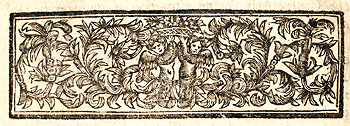 |
| Title page of Brickell's, Natural History |
A native of Ireland, John Brickell (1710-1745) accompanied the future provincial governor, George Burrington, to Edenton, North Carolina in 1724, an event that served as the wellspring for his enduring reputation as a promoter and observer of the colonial southeast. Yet for all of Brickell's energies on behalf of the colonies, he spent fewer than six years there, returning to England in 1731.
Like his predecessor, John Lawson, Brickell was eager to explore the interior reaches of colony to evaluate its economic potential, so much of which was wrapped up in consideration of the colony's natural productions. As a member of a party of ten, he explored the interior of the province as far west as Tennessee, summarizing his observations, hopes, and expectations in a work of popular science, The Natural History of North Carolina. Drawing heavily upon Lawson's History of Carolina -- often plagiarizing by modern standards -- Brickell's Natural History is distinguished by its close attention to the health conditions of the colony and to the medical practices of its Indian residents. Not quite as acute an observer as Lawson, Brickell's efforts to describe the disease environment of the early colonial Southeast and the tenor of his descriptions of Indians nevertheless made his work valuable to historians.
 |
Brickell's list of 'Insects of Carolina'
(click to read about beasts) |
In this pre-Darwinian and, for all intents and purposes, pre-Linnean world, biotic classification was a rough hewn affair, and the taxonomic categories employed by Brickell in describing the flora and fauna of Carolina confound our own. While modern readers might agree that a "rotten-wood worm" might be categorized as an insect, for example, few of us would include snakes and alligators in the same category. Like Lawson, Brickell too considered the study of Indians to be a part of Natural History, and he included discussions of Indian culture as well as a valuable
vocabulary of the Tuscarora, "Pampticough," and Waccon languages. Like Lawson, he was particularly intent upon understanding the provides a taste of his concerns:
 |
| Brickell's illustration of the Buffalo |
As for the Indian Women, which now happen in my Way; when young, and at Maturity, they are as fine-shap'd Creatures (take them generally) as any in the Universe. They are of a tawny Complexion; their Eyes very brisk and amorous; their Smiles afford the finest Composure a Face can posess, their Hands are of the finest Make, with small long Fingers, and as soft as their Cheeks; and their whole Bodies of a smooth Nature. They are no uncouth or unlikely, as we suppose them; nor are they Strangers or not Proficients in the soft Passion. They are most of them mercenary, except the married Women, who sometimes bestow their Favours also to some or other, in their Husbands Absence. For which they never ask any Reward. As for the Report, that they are never found unconstant, like the Europeans, it is wholly false; for were the old World and the new one put into a Pair of Scales (in point of Constancy) it would be a hard Matter to discern which was the heavier.
 |
Polecat, as depicted in Brickell's Natural History
(click to see Mark Catesby's polecat) |
In addition to Indians, the relatively elastic conception of Natural History employed by Brickell also encompassed the colony's burgeoning number of Africans. Even as early as the late 1720s, African slavery had become integral to the colony's culture and economy, a fact that the promoter Brickell did not ignore. While acknowledging that Africans had demonstrated a range of intellectual and productive capacities, from learning to read and write to mastering the intricacies of the manual arts and trades, he was disinclined to cede any emotional depth to them as slaves. He remained noncommittal on the moral status of slavery: even his criticisms of the institution are made carefully, respecting, if not reflecting the planters' perspective.
The Planters at their Death used to make some of their favourite Negroes free, but there is now an established Law (especially in Virginia) that if they do not quit the Province in about Eleven Days after their Freedom, whoever takes them they become his Property... The Planters seeing the Inconveniencies that might attend these kind of Priviledges to the Negroes, have this and all other Laws against them continually put in practice, to prevent all Opportunities they might lay hold of to make themselves formidable.
The volume includes a
folding map and 4 engraved plates of birds, beasts, and fishes. The APS copy of Brickell's
History was acquired in 1968.]





